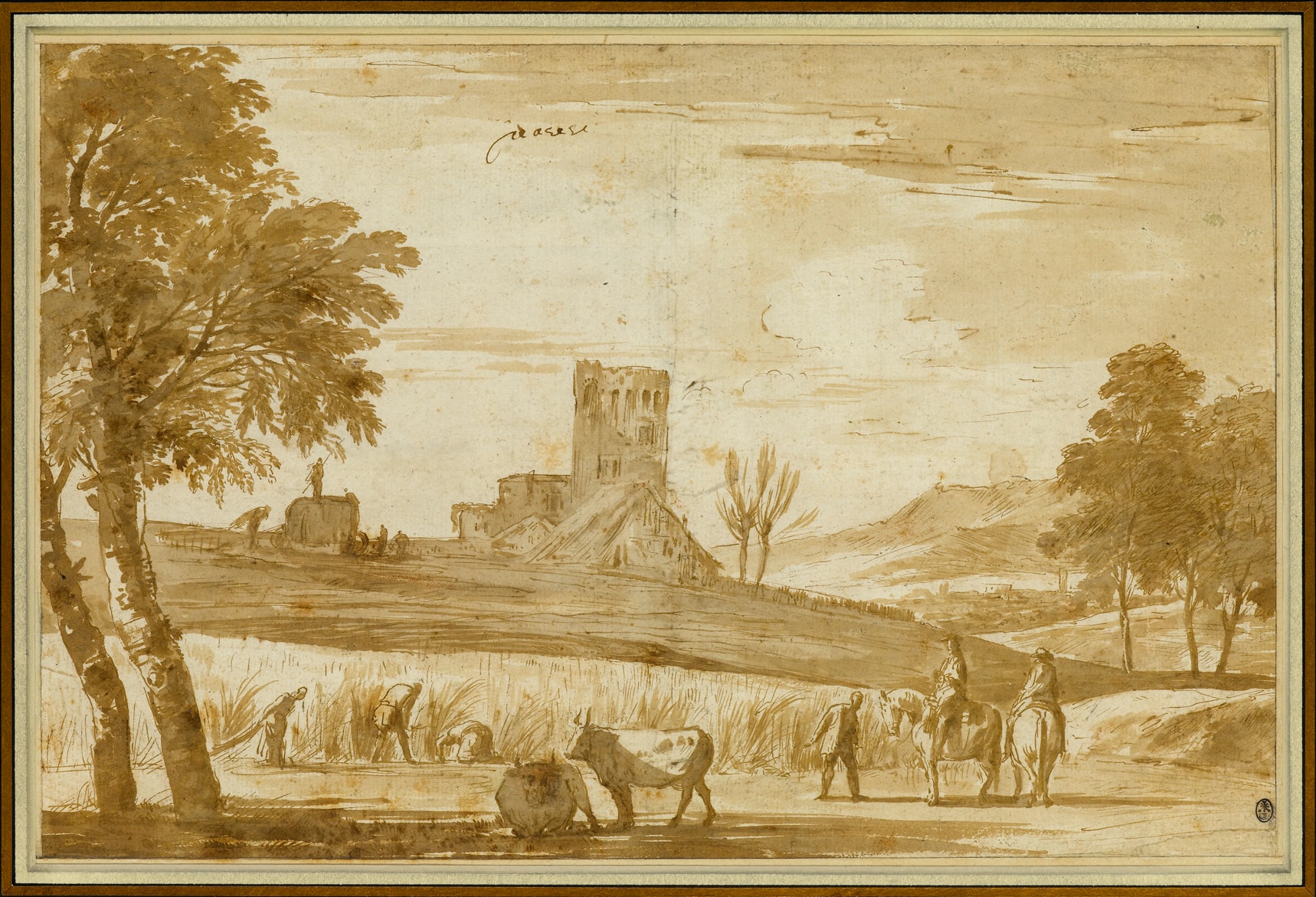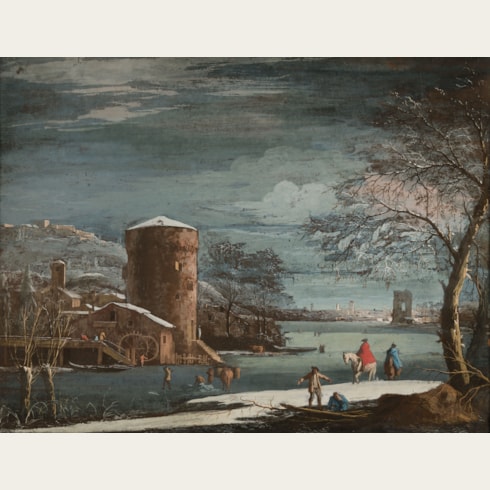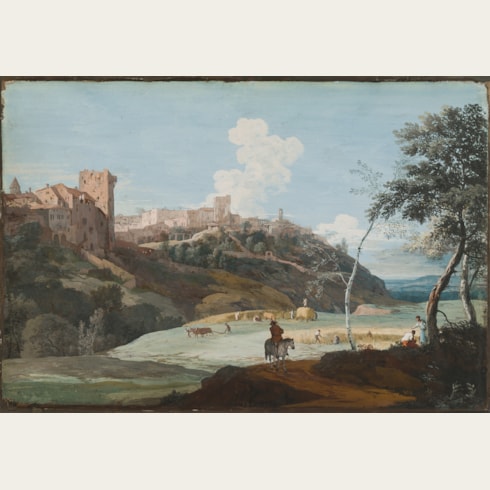Marco RICCI
(Belluno 1676 - Venice 1730)
Landscape with Harvesters, a Castle Beyond
Sold
Pen and brown ink and brown wash, laid down on a Vivant Denon mount.
Inscribed paese at the upper left centre.
Indistinctly inscribed Ricci anno del 1720 on the verso, laid down.
193 x 287 mm. (7 5/8 x 11 1/4 in.)
ACQUIRED BY THE GRAPHISCHE SAMMLUNG ETH, ZURICH.
Inscribed paese at the upper left centre.
Indistinctly inscribed Ricci anno del 1720 on the verso, laid down.
193 x 287 mm. (7 5/8 x 11 1/4 in.)
ACQUIRED BY THE GRAPHISCHE SAMMLUNG ETH, ZURICH.
This charming, fresh landscape may have been intended as an independent work, like the artist’s better-known gouache landscapes. The chronology of these pen drawings is difficult to establish, as only two dated examples are known. Ricci would often keep these drawings in his studio, to be used as a source of pictorial motifs in his paintings and etchings.
This drawing bears the collector’s mark of Dominique-Vivant Denon (1747-1825), the most powerful administrator of the arts in Napoleonic France. A diplomat, writer, archaeologist and engraver, he was also a discerning and wide-ranging art collector. Denon’s collection of drawings numbered around 1,400 sheets, of which slightly more than half were by Italian artists.
This drawing bears the collector’s mark of Dominique-Vivant Denon (1747-1825), the most powerful administrator of the arts in Napoleonic France. A diplomat, writer, archaeologist and engraver, he was also a discerning and wide-ranging art collector. Denon’s collection of drawings numbered around 1,400 sheets, of which slightly more than half were by Italian artists.
Marco Ricci received his artistic training in the studio of his uncle Sebastiano Ricci, with whom he often later collaborated. A landscape painter first and foremost, he completed the landscape backgrounds in Sebastiano’s canvases, and is also known to have assisted other artists, including the Genoese painter Alessandro Magnasco. Marco Ricci worked initially in Venice, although he fled the city in the late 1690s after killing a gondolier in a tavern brawl, apparently by breaking a jug over his head. He returned to Venice in the early years of the 18th century, and later worked in Florence and Rome. He also developed a reputation as a theatrical painter, working in this field in Venice and London. In the autumn of 1708, at the invitation of the British ambassador in Venice, Charles Montagu, 4th Earl (later Duke) of Manchester, Ricci made the first of two trips to England. He worked alongside Giovanni Antonio Pellegrini on the decoration of Burlington House in London, Kimbolton Castle in Cambridgeshire and Castle Howard in Yorkshire, and also designed scenery for the Italian Opera at the King’s Theatre, Haymarket. He left England in 1710 but returned for a second time with Sebastiano in 1712, remaining there until 1716 before returning to settle in Venice. Together with his uncle and several other prominent artists, Ricci was commissioned by the entrepreneur Owen McSwiny to paint a series of allegorical tombs dedicated to prominent English noblemen; his Monument to the Duke of Devonshire was completed in 1725. In many of his paintings, gouaches and drawings can be seen the particular influence of the Dutch and Flemish landscape tradition of the previous century. Furthermore, as one recent scholar has noted, ‘Evidently Ricci was prepared to try his hand at different styles and techniques. He was receptive to varying landscape styles, agreeable to collaborative efforts, willing to produce different types of imagery, and capable of painting pastorals or storms, delapidated ruins or busy little towns, in either oils or tempera.’ Perhaps encouraged by the connoisseur and publisher Anton Maria Zanetti, Ricci took up printmaking around 1723. Some thirty-three etchings by him are known, twenty of which were included in the series Varia Marci Ricci Pictoris Praestantissimi Experimenta, published by Carlo Orsolini in Venice in 1730, the year of the artist’s death.
As a draughtsman, Marco Ricci is best known for his landscapes drawn in pen and ink, as well as for the distinctive gouache landscapes that he had begun to produce by the time of his second visit to England in 1712, and which appear to have been his invention. Two large collections of Ricci’s drawings were formed in his lifetime; that of Zanetti, who owned 141 drawings by the artist mounted into an album, now dispersed, as well as a large number of gouache landscapes, and that of Consul Joseph Smith, whose collection of 146 drawings, 32 gouaches and 136 caricatures by Ricci is today in the Royal Collection at Windsor Castle.
Provenance
Baron Dominique-Vivant Denon, Paris (Lugt 779 and on his mount)
His sale, Paris, 1-19 May 1826, part of lot 553
Anonymous sale, New York, Christie’s, 12 January 1995, lot 49
Private collection, Florida.
Literature
A. N. Pérignon, Description des objets d’arts qui composent le cabinet de feu M. le Baron V. Denon, Paris, 1826, p.149, under no.553 (‘Cinq paysages, par Marco Ricci et Guardi; les uns à la plume seulement, les autres à la plume et au lavis.’); Marie-Anne Dupuy, ‘Liste des tableaux et dessins de la collection Denon identifiés’, in Paris, Musée du Louvre, Dominique-Vivant Denon: L’oeil de Napoléon, exhibition catalogue, 1999-2000, p.513.







